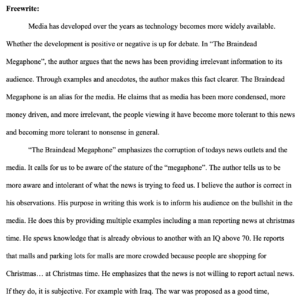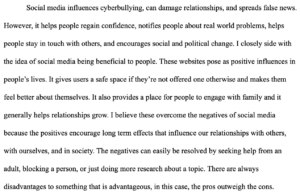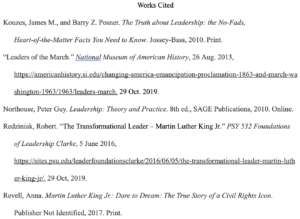Throughout the course of this semester, I truly believe I have improved my writing skills, which were the targets of the FIQWS 10108 course objectives. I was able to improve and develop strategies for my writing and prewriting, as well as engaging in the social aspects of the writing process by practicing freewriting and group revising. I was also able to recognize and practice rhetorical terms. I focused on all five rhetorical situations, purpose, audience, genre, media/design, and stance, in almost all of my assignments. With my knowledge of rhetorical situations, I employed stance and other strategies in my writing, an example being within my journals. I was able to utilize City College’s extensive array of online sources through their library’s databases during the research I conducted for my critical analysis research essay. Lastly, I gained more knowledge on citing and was able to improve and accurately cite my sources within my writing. I am still currently practicing course objectives, specifically that of using print and digital technologies to address a range of audiences. I am specifically doing this right now by creating this portfolio online and publicly.
I was able to fulfill the course objectives “develop strategies for reading, drafting, collaborating, revising, and editing” and “Engage in the collaborative and social aspects of writing processes” multiple times throughout the semester. An example of my drafting had been while writing my summary and response essay. I was to pick between “The Braindead Megaphone” by George Saunders and “Black Men and Public Space” by Brent Staples. Originally, I had planned on writing about Saunders’ essay, however through the freewriting exercise (Fig. 1), I realized I connected more with Staples’ essay. I also created a habit of noting and annotating quotes based on how useful they would be to my writing. As for the revision, collaboration, and social aspects of writing, I was able to practice this through group exercises performed in class. I was able to receive feedback on my writing, which in turn allowed me to improve my writing and make it stronger (Fig. 2, 3, & 4).
Figure 1:

Figure 2:

Figure 3:

Figure 4:

Rhetorical situations were the main aspect of this class. “Recognize and practice key rhetorical terms and strategies when engaged in writing situations” was a key component of my writing. An example of this was in my summary and response essay, a few of the situations I used were audience and purpose. I utilized audience by clarifying who the targeted audience of Staples’ short essay and how his audience played a part in purpose (Fig. 5).
Figure 5:

My exploratory essay was an example where I demonstrated the course objective which asks to “compose texts that integrate your stance with appropriate sources using strategies such as summary, critical analysis, interpretation, synthesis, and argumentation”. I believe my stance, or tone, in this essay is pensive. By maintaining an objective position through analyzing and researching my question, whether or not social media is beneficial to our society, it demonstrates that I thought out possible answers before forming a conclusion (Fig. 6).
Figure 6:

Truthfully, although I used City College’s library database, it was the course objective I practiced the least. I utilized the database to begin conducting my research on my leader for my critical analysis research essay. My leader, Dr. Martin Luther King Jr., played an essential role in the March on Washington for Jobs and Freedom. Wanting to learn more about his role, I researched him on the database. However, my research was inconclusive. Many of the sources I found focused more on the event rather than the masterminds behind it (Fig. 7).
Figure 7:

This course has allowed me to work on the course objective of practicing “systematic application of citation conventions”. This has been done in every assignment, figure eight will be my citations for my critical analysis research essay. My works cited pages and using in text citations allowed me to improve and strengthen my ability to accurately cite. However, before citing, I needed knowledge on how to research and choose credible sources. I practiced this through many lessons: within the Norton Field Guide to Writing, through classes in the library, and even through a journal (Fig. 9).
Figure 8:

Figure 9:

The last course objective, to “understand and use print and digital technologies to address a range of audiences,” is an objective I am practicing right now while you read this reflection. Using digital technologies, my audience is anyone who comes across my website on the CUNY Academic common. Using print technologies, as I have many papers, my audience is simply Professor Rogal and any peers who proofread my work.
This semester with Professor Rogal in FIQWS 10108, I practice objectives and skills which have immensely altered and improved my writing and my writing process. I am more likely to begin writing my papers earlier by freewriting and making sure I truly can write about the topic I am writing about. In addition, I am now more observant and keep in mind possible quotes or details that may support my future theses. Not only this, but it has allowed me to work on the way I analyze texts. Through the rhetorical situations, I am able to synthesize texts and get the most out of what I read. I am certain that this course has tremendously improved my writing.



